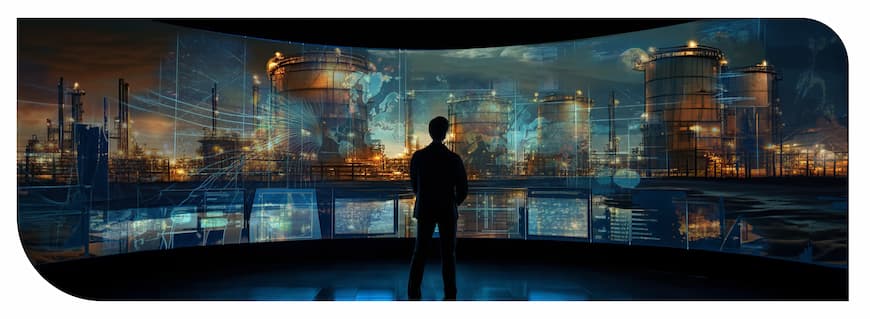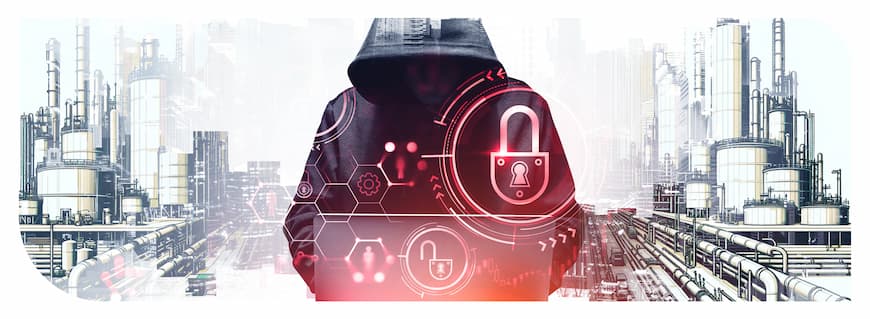Best practices for protecting critical infrastructure in the oil and gas sector.
In today's hyper-connected world, the significance of robust cybersecurity measures cannot be overemphasized. For industries as critical as oil and gas, an inadvertent cyberattack could spell disaster, disrupting national economies and endangering public safety. This article delves into the critical cybersecurity threats menacing the oil and gas infrastructure and examines best practices for safeguarding these vital sectors.
- Understanding the primary cybersecurity threats
- Exploring the cybersecurity landscape within the oil and gas sector
- Identifying best strategies for protecting critical infrastructure

Join us as we navigate this complex realm of risks, strategies, and solutions, enabling you to fortify your cybersecurity defences effectively in the face of evolving threats.
Understanding the primary cybersecurity threats

In the context of the oil and gas sector, understanding the primary cybersecurity threats comes as the first step in building a robust defense. The industry's increasing investment in smart technology and digitization only adds to the risk profile, making the need for cybersecurity protection more pronounced. Cyber threats to the sector take many forms, ranging from malicious software attacks, data breaches, to unauthorized access to control systems.
Perhaps one of the more insidious threats is the growing sophistication of cyber-attacks. Threat actors are leveraging advanced techniques, like spear-phishing and ransomware, to gain unauthorized access to confidential information, disrupt operations, or even commandeer control systems. As such, a defensive strategy that once worked may not be sufficient to protect against current and evolving threats.
Another area of concern pertains to loopholes in remote access security, an issue that surfaces more prominently with prevalent remote work environments.
Remote work has undeniably been a boon for operational flexibility, but it has also been a magnet for hackers seeking easy ingress points. Therefore, addressing vulnerabilities in remote access is an essential aspect of a holistic cybersecurity framework.
Intellectual property theft is another primary threat to the sector. Industrial espionage, perpetrated by both state-sponsored actors and independent hackers, can cripple a company's competitive advantage and have long-term detrimental effects.
Grasping the salient points of these threats is the first crucial step towards developing a proactive approach to cyber resilience. Next, organizations must prioritize initiatives to identify vulnerabilities, strengthen defense mechanisms, and create a multi-faceted strategy for comprehensive risk management.
Exploring the cybersecurity landscape within the oil and gas sector

When it comes to exploring the cybersecurity landscape within the oil and gas sector, there's a certain complexity that must be understood. Due to the sector's heavy reliance on interconnected systems and digitalized operations, the potential for an opportunistic cyberattack is high, making it a prime target for attackers seeking opportunities to exploit vulnerabilities.
The oil and gas infrastructure is a tightly-knit network of extraction, production, refining, and distribution. Each of these elements is controlled by intricate industrial control systems (ICS) which are vulnerable targets for hackers.
When these systems are compromised, the effects can be catastrophic, leading to disrupted operations, compromised proprietary information, and at worst, devastating environmental damage.
It doesn't stop there, though. Cyber threats aren't strictly external; internal threats pose a significant risk as well. Whether through intentional malevolence or inadvertent actions, employees can inadvertently become a conduit for cyber-attacks. Thus, a solid cybersecurity framework also encompasses strategies to mitigate insider threats.
In order to safeguard their critical infrastructures, oil and gas companies must embrace effective cyber defensive measures. This includes consistent network monitoring, implementing advanced threat detection tools, and ensuring industrial control systems are secure from potential infiltration.
Furthermore, regular training of staff to recognize and promptly report potential security threats is also vital in building a robust cybersecurity infrastructure.
International cooperation and information sharing within the industry is another crucial factor in combating cyber threats. By establishing collaborative networks, companies can pool their resources to craft more comprehensive defensive strategies, stay updated on emerging cyber threat trends, and contribute towards an industry-wide resilient framework. It's clear; a proactive and collective response is an indispensable tool in strengthening defenses against the continuously evolving cyber threatscape.
Common types of cyber attacks on the oil and gas industry

Ransomware
Recent trends highlight a few common types of cyberattacks targeting the oil and gas sector. Notable among them is ransomware, where hackers lock the system and demand a ransom to unlock it. This form of attack can halt operations, cause huge financial losses, compromise safety measures, and result in a leak ofsensitive information.
Phishing
Another significantly prevalent attack is spear phishing. Here, the attackers send personalized emails appearing to come from credible sources to trick the recipient into revealing confidential information, such as login credentials.
DDoS
A further threat that you need to be vigilant of is Distributed Denial of Service (DDoS) attacks. In this scenario, attackers aim to overload the system with excessive traffic, rendering it unable to function and causing disruptions in thesupply chain.
APTs
Lastly,Advanced Persistent Threats (APTs) cannot be ignored. Here, hackers gain unauthorized access to the network and remain undetected for a prolonged period, systematically stealing sensitive information and possibly altering system controls.
Understanding these common cyber threats is pivotal to enhancing your organization's cybersecurity defenses and ensuring the safety of your critical infrastructure.
Best strategies for protecting critical infrastructure

Your oil and gas company's critical infrastructure protection begins with a solid cybersecurity framework. Here are ten fundamental strategies that can help ensure a safe environment:
- Prioritizing Cybersecurity Investment: Given the gravity of potential threats, it's crucial to allocate funding to enhance cybersecurity measures, ensuring your infrastructure's safety.
- Construct with Cybersecurity in Mind: Your infrastructure design should encompass strong cybersecurity elements. This practice assists in preventing cyber threats before they emerge.
- Continuous Risk Management: Staying proactive in identifying and managing risks can ensure that vulnerabilities are dealt with promptly and effectively. Ongoing risk assessments and reviews are critical in maintaining a robust cybersecurity posture.
- Workforce Training: Your employees are your first line of defense. Regular training on cybersecurity best practices and threat awareness will reduce the probability of accidental security breaches.
- Use of Virtual Data Rooms: Solutions like ShareVault provide secure, regulated access to sensitive data. It also offers real-time tracking of who has accessed what information, when, and from where, adding an additional layer of security.
- Incorporating Security into Business Planning: Cybersecurity measures mustn't be an afterthought. Instead, it should be an integral part of business planning and strategy.
- Implementing Multi-factor Authentication: It adds an extra line of defense to your cybersecurity measures, making it harder for cybercriminals to breach your systems.
- Securing Physical Access Points: While digital protection is crucial, physical security measures — such as secured access to server rooms — should also be taken seriously.
- Collaboration with cyber security firms: Companies like Claroty focus on purpose-built cybersecurity strategies for oil and gas companies, helping them to protect their critical infrastructure.
- Nurturing a Cybersecurity Culture: A culture that respects and understands the importance of cybersecurity can significantly aid your security measures. Encourage everyone in your organization to take responsibility and be proactive in maintaining security layers.
By embracing these best practices, oil and gas companies will be well-positioned to fortify their cyber defenses, securing their critical infrastructure from would-be attackers.
Staying Ahead: Predicting and Preventing Future Cybersecurity Threats in the Oil and Gas Sector

Considering the rapidly evolving technological landscape, it is paramount that oil and gas companies stay one step ahead of potential risks. The mounting threats from cybercriminals call for proactive, rather than reactive, measures. It's time to transcend traditional security methods and adopt advanced solutions. The nation's critical infrastructure is too important to await a breach before investing in comprehensive cybersecurity strategies.
Critical to staying ahead is fostering a culture of industry-wide collaboration. Frequently exchanging threat intelligence with international bodies and developing robust cybersecurity defenses can effectively mitigate cyber risks. Companies also need to conduct regular risk assessments to identify and address both internal and external cyber threats.
This enables an understanding of vulnerabilities which could be exploited by malicious cyber actors, thereby informing improvements to the systems.
Given the increasing reliance on digital technology, the design of oil and gas systems should incorporate cybersecurity considerations from the outset. However, implementing cybersecurity measures isn't a one-time action but a continuous process. The goal should be to reach a level of high cyber resilience, capable of withstanding attempts to disrupt operations and ensuring safety.
This resilience is crucial, not just for the individual companies, but for the global economy and supply chains that rely heavily on the oil and gas sector. With the right investments in cybersecurity, the oil and gas industry can strengthen its defenses and take significant strides in protecting against future attacks.
Emphasizing cybersecurity today means a more secure and resilient oil and gas infrastructure tomorrow. The course has been set, and it's now up to the sector to accelerate their efforts and take a leading role in shaping the future of cybersecurity.
It's not just an investment in technology, but a commitment to ensuring the continuity and safety of operations that literally fuel the world.
If you want to see how ShareVault virtual data room's advanced security features can help give you peace of mind and protect your next deal from cyber threats get in touch for a free demo and our industry experts will show you how we can protect you
